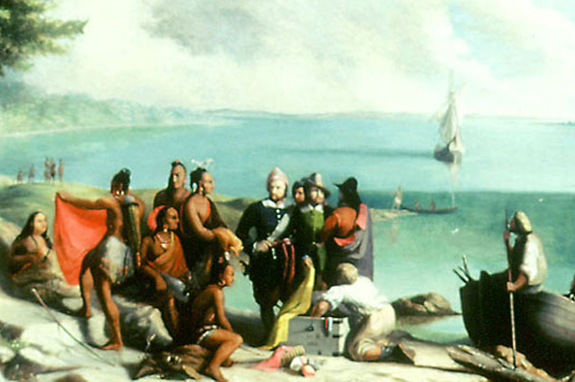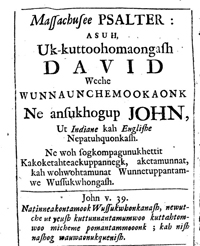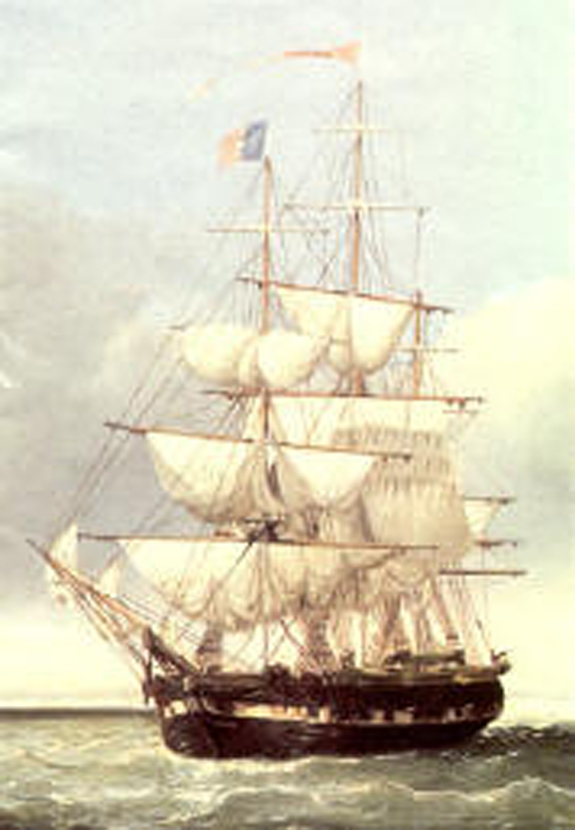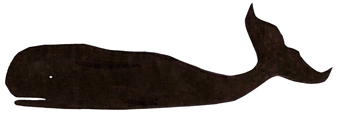| |
Local New Bedford, Ma. History
1600 - 1699 In Chronological Order
|
The Native Americans lived here for a long, long
time, then
the white man came and for the
Native
Americans everything
went down hill. |
Prior to the European colonist's arrival, the Wampanoags had settled along the Acushnet River
and had a population numbering about 12,000 |
| |
AD 1,000+
Buzzards bay was discovered by the Northmen (Norsemen) in the tenth century and by them named
Stromfiord (according to Rickettson's book of local history). |
| |
1602
Marked the first visit by a European to Cape Cod and Southeastern New England. Bartholemew Gosnold makes landings on Cape Cod, the Elizabeth Islands, and the coast of Buzzard's Bay.
He had sailed from Falmouth England in a ship named the "Concord" with the goal of establishing a more direct route to America and establishing a plantation. He came around Cape Cod and named it because of the large amount of fish he saw there finally landing on what is today Cuttyhunk on May 24, 1602. He named it Elizabeth after the queen of England at the time.
He found a small pond on the island that itself had an island in it. Gosnold then built a flat bottomed boat and went to the island and there he built a fort with a storehouse.
While this was going on, he was curious to see more of the mainland and took the bark and a few men to explore. He landed at the area now known as Round Hill in Dartmouth.
They were cordially greeted by native men, women and children who made them presents of "Skins of wild beasts, tobacco, sassafras root, turtles, hemp, colored strings (wampum), and such like things.
Gosnold found these natives "A fair conditioned people." and "The main, the goodliest continent he had ever seen promising more by far than we any way did expect, for it is replenished with fair fields and fragrant flowers, also meadows and hedged in with stately groves, being furnished also with pleasant brooks and beautified with two main rivers."
They were the advance guard for the march of civilization to New England.
At time for departure on June, 18th, 1602 Gosnold was supposed to leave a group of men behind to establish a plantation, but the men fearing that they would lose their shares of the proceeds from the bounty brought back to England and fearing the possibility of hostility with the natives, all left and none stayed behind.
They had left
behind the remains of a small fortified house on a tiny island in the middle of a small pond on the island. The archeological remains of the foundation can be seen today.
The Town on Cuttyhunk Island (Gosnold) is later named after him.
He had explored the harbor where New Bedford is today. The image above is that of "Smoking Rocks" supposedly where the old Gas and Electric company was located on the shore of New Bedford.
There, he met with and traded with the local Indians.
There is a monument erected in 1903, and dedicated to Gosnold on the tiny island in the small pond on Cuttyhunk. |
|
1623
From 1623 until 1675 there was a succession of disturbances between the colonists and the Native Americans and not without reason.
The encroachment on their lands, the enmity of the white man trying to settle Native American disputes, as well as frequent wrongs perpetrated by the white man, all this and more brought on the clash of arms.
The native Americans had traditionally used knives, tomahawks and bow and arrows but by this time had acquired guns and used them as did the settlers. |
| |
1652
Russell's Mills was begun here by Ralph Russell who came from Taunton or Raynham in 1652 and this was the first area to be settled in the original Old Dartmouth.
He established an iron forge and other machinery on the Paskamansett River, later known as Slocum's River. |
| |
1652
A deed signed in New Plymouth. A group thirty-six settlers purchased thirty-four shares of the parcel of land that is now the area of New Bedford, Acushnet, Fairhaven, Dartmouth and Westport .
It is bought from Massasoit who was the Grand Sachem of the Wampanoag, and his son Wamsutta.
It was called Dartmouth and covered a large amount of land that today is Westport, Dartmouth, New Bedford, Acushnet and Fairhaven
The deed signed New Plymouth, November the 29th 1652.
Know all men by these presents, that I, Wesamequen, and Wamsutta my son, have sold unto Mr. William Bradford, Captain Standish, Thomas Southworth, John Winslow, John Cooke and their associates, the purchasers or old-comers, all the tract or tracts of land lying three miles eastward from a river called Cushenagg, to a certain harbour called Acoaksett, to a flat rock on the westerward side of said harbour. And whereas the said harbour divideth itself into severall branches, the westernmost arme to be the bound, and all the tract or tracts of land from the said westernmost arme to the said river of Cushenagg, three miles eastward of the same, with all the profits and benefits within the said tract, with all the rivers, creeks, meadows, necks and islands that lye in or before the same, and from the sea upward to go so high that the English may not be annoyed by the hunting of the Indians in any sort of their cattle. And I, Wesamequen and Wamsutta, have fully bargained and sold unto the aforesaid Mr. William Bradford, Captain Standish, Thomas Southworth, John Winslow, John Cooke, and the rest of their associates, the purchasers or old-comers, to have and to hold for them and their heirs and assignes forever. And in consideration hereof, we the above-mentioned are to pay to the said Wesamequen and Wamsutta as followeth: thirty yards of cloth, eight mooseskins, fifteen axes, fifteen hoes, fifteen pairs of breeches, eight blankets, two kettles, one cloak, 2 lb in wampam, eight pairs of stockings, eight pairs of shoes, one iron pot, and ten shillings in another commoditie. And in witness hereof we have interchangeably set to our hands the day and year above written.
In the presence of
JOHN WINSLOW
JONATHAN SHAW JOHN COOKE
SAMUEL EDDY
WAMSUTTA
Whereas, according to an order of court, held at Plymouth, bearing date the third day of October Anno Domini 1664, wherein Philip, Sagamore of Pockannockett, &c., was desired to appoint and agent or more to set out and mark the bounds of Acushna, Coaksett, and places adjacent, the said Sachem sent John Sassamon, on the 19th day of November, in the year aforesaid, to act in his behalf in the premises, whoe hath set the bounds of the said tract and tracts as followeth, viz: at Acushena three miles to the east according to the deed bearing the date November 29th 1652, from a black oak marked on four sides, running upward north into the woods eight miles, and downward south with so much of the island Nakata as falls within the said line; at Akoaksett, from a white oak marked on four sides, standing on the west side of the head of the cove, ranging up into the woods north six miles and an half to a great pond, unto a white oak marked, standing on the west side of the pond, near the south end of the said pond; by reason of the running of the pond, one mile on the east side upward to a black oak marked on four sides, standing near a maple tree on the side of the said pond, about the middle of it, which pond is called Watuppa; the upper bounds to run from tree to tree upon a strait line, and at the head of the westernmost arm from the said white oak to the flat rock expressed in the deed aforesaid. |
|
1656
As an example of the religious differences, and lack of religious tolerance at the time,
Mary Fisher and Ann Austin both Quakers arrived from England.
They were promptly arrested and their trunks searched by the order of Boston's Deputy-Governor Bellingham and a number of books were taken therefrom and were burned in the marketplace by the hangman of the colony.
The women were closely imprisoned and no communication was allowed them. |
| |
1660
In New England and most likely in Dartmouth as well the literacy rate was 60% for men and 30% for women.
The Massachusett Indian language had been translated from a spoken language into a written form by John Elliot of Cambridge and in the next few years some Indians were learning to read it.
By the next few years besides a basic primer there was a complete bible in 1663 and song book (psalter) printed in the Massachusett language.
He had printed enough bibles that there would be one for more than every 3 Indians.
Almost none exist at this time.
Click on the image for a larger version. |
| |
1661
Death of Massasoit. |
| |
1662
Plymouth Colony listed seven men on it's tax rolls for Old Dartmouth. |
| |
1663
John Russell built a home and converted it to a protective garrison at a site just north of Bush Street in South Dartmouth.
This defensive structure was very important as the Native Americans were attacking and burning homes in the area. A number of settlers took refuge there. |
| |
1664
June, The court in Plymouth allows that the land known as Acushena, Ponagansett and Coaksett is allowed by the court to be a township. At the time Dartmouth is finally incorporated.. |
| |
1665
Prior to this year John Russell and Anthony Slocum built an iron foundry and got the raw material (bog iron) from the Russell's Mills area.. |
| |
1665
June - Dartmouth portion of the rate of taxes 10 Pounds |
| |
1667 June
Serjeant James Shaw and Arthur Hatherway are appointed to exercise the men in armes in the town of Dartmouth.(As per court in Plymouth). The people were prepared to intelligently defend their homes from their enemies. ( Note: The Quakers would rarely bear arms against another man). |
| |
1667July
For the town of Dartmouth
"John Cooke is authorized by the Court to make contracts of marriage in the town of Dartmouth and likewise administer an oath to give evidence to the Grand Inquest and to likewise administer an oath to any witness for the trial of a case as occasion may require; and in case any person or persons residing in this jurisdiction shall have occasion to commence a suit against any stranger or foreigner, it shall be lawful for the said John Cooke to issue out warrants in His Majestie's name, to bind over any person or persons to answer said suit at His Majestie's Court to be holden at Plymouth at any time, by attachment or summons, as occasion may require, and that he shall give forth subpoenies to warn witnesses" Book 4 Court Orders page 163 (Plymouth Court) |
| |
1671
The court in Plymouth orders the village of Dartmouth (currently New Bedford) to gather the sum of 15 pounds to,
"Be kept in stock toward the support of such as may dispense the word of God unto them". The village had failed to follow a similar order from the previous year. The Quaker settlers in Dartmouth were at odds about this with the Puritan settlers in Plymouth. |
| |
1671
Arthur Hathaway is appointed by court to administer an oath to any witness to give evidence to the Grand Inquest in that town as occasions may require. |
| |
1673 March
John Smith of Dartmouth is appointed to be Lieutenant of the military company and Jacob Mitchell to be ensign bearer of said company. |
| |
1674
" On Wednesday the 24'th of this instant" The court in Plymouth ordered that inhabitants and purchasers of Dartmouth,
"Gather together for the purposes of settling the boundaries of their town... and that some provision be made for the preaching of the word of God amongst them". |
| |
1675
The murder of a native American named Sassamon started a big problem between the settlers and the Natives. Sassamon had learned that King Philip was planning and attack on the settlers and making plans for a war.
He went to Plymouth and told the authorities there of King Philip's hostile intentions.
The Plymouth authorities called for King Philip to appear.
They then learned that Sassamon had been murdered by the natives and his body thrown under the ice in the pond in Middleborough.
Sassamon was able to read and write in both English and the Massachusett (Indian) language. He was a Christian preacher and had lived with whites in his youth. He was resented by King Philip and other indians who did not want to be influenced by the English ways and did not want to be converted to Christianity.
(John Elliot of Cambridge had transcribed the oral Massachusett language to written)
Two suspected, natives were arrested and tried before and English jury and condemned.
On April 8, 1675 two days before the scheduled execution war dances were held by the natives (Saganites).
The day after the squaw sachem, Weetamo, met Captain Church in Rhode Island and told him that Philip intended to begin a war on the English settlements and had already granted authority to his people to kill the cattle of the settlers. |
| |
1675 June 29
Metacomet whose English name was King Philip and his 500 warriors ( Pokanokets) and, supported by 800 Narragansett warriors went on the warpath.
They first destroyed two houses in Swansea then in quick succession burned villages of Middleborough, Taunton, Rehoboth, Dartmouth and other like towns.
They burned nearly 30 houses in Dartmouth killing the people in a most barbarous manner, skinning them all over alive, some only their heads and others cutting off their hands and feet.
The women they defiled and afterward put them to death by these or some like ways".
Increase Mather (a chronicler of the time) in his account states "Dartmouth they did burn with fire and barbarously murdered both men and women; stripping the slain, whether men or women, and leaving them in the open field as naked as the day wherein they were born.
Such, also, is their inhumanity that they flay off the skin from their faces and heads that they get into their hands, and go away with the hairy scalp of their enemies."
Many cattle had their bellies cut open therefore to drag their intestines along the ground for days until they died or they cut off one leg so as to cripple them..
The scattered homes were easy prey and those who fled to the garrisons fared better. There were three main garrisons.
One was on the north bank of the Apponagansett River. It was Russell's Garrison, situated on land about a mile from the mouth of the river..
Another garrison was near the shore close to the present site of the Riverside cemetery in the village of Oxford ( part of present day Fairhaven) it was north of the Coggeshall bridge and 600 feet from Main street.
The other was on Palmer's island in the harbor of present day New Bedford.
Read more about Palmer's Island
The defenders used a matchlock , sword and hatchet to defend their loved ones from the enemy. |
| |
1675 to 1676
The result of the war was six hundred settlers killed and thirteen towns totally destroyed by fire.
Altogether six hundred homes were lost.
Many colonists were tortured to death as their homes and farms were burned and pillaged.
The colonized area was almost completely destroyed except a very few homes that were away from the main settlements and the home of John Russell, known as Russell's' Garrison.
On the 14th of October in 1675 the court in Plymouth (book 5 Court Orders Page 102) made a decree that essentially said that the residents of the Old Dartmouth area should build and live in garrisons for their protection and pay closer attention to the religious sermons, and that the troubles were caused because it was God who was chastising them for their contempt of his gospel.
John Cooke, a Baptist preacher, who came here with his father on the Mayflower became a prominent figure in the area. The ruins of his home in Oxford Village became the meeting place for Church's soldiers in the persecution of King Philips War.
An event was remembered for a long time; after the cessation of hostilities a company of natives surrendered themselves as prisoners to Captain Eels, of Russell's Garrison.
He and Ralph Earl had made them promises which the natives accepted in good faith and they were camped near the garrison when Plymouth soldiers under the command of the famous Indian fighter Captain Benjamin Church arrived.
They had been sent there to relieve the settlers by the Plymouth authorities.
Despite the promises made to them 160 natives were marched by the Plymouth soldiers from Dartmouth through present day New Bedford at the head of Clark's Cove and down County street to Acushnet then on to Plymouth.
On August 2, 1676 Philip's wife Wootonekanuske and their 9 year old son were captured but Philip got away.
On August 12, 1676 Church's troops had caught up to Philip at Mt Hope area in Miery Swamp. One of the Indians named John Alderman who was allied with Church shot Philip dead there on the spot. Church had Philip's body dragged out of the swamp and had it chopped in to pieces with 4 large pieces hung from 4 trees. The head went to Plymouth to be displayed on a pole there for 25 years as a warning. Philip's scarred right hand was given to the indian John Alderman as a prize for shooting him.
For years Alderman earned money by displaying the hand preserved in a bucket of rum.
There a total of 178 natives including King Philips wife and son were held in a terrible jail. Many stood trial and were condemned and were sold into slavery to the Spanish who shipped them off to the West Indies. ( In the book "Queen of the Republics" published in the late 1890's it is said that Philip's son was sold into slavery). Several sources say that he was sent to the West indies and yet another source said it was Bermuda. The strongest information from multiple sources is that it was the West Indies.
According to a historian named Belknap some of them made it back and found opportunity to seek revenge during a war with the French and Indians known as King William's war.
For several years Plymouth suspended taxes on the area out of pity for the near total destruction of the settlements. Only after the death of King Philip did the area again rebound.
It was not one sided although in the beginning the Indians massacred a large amount of the local population of English, in the end the natives were decimated and finally the Wampanoag Federation was no longer a nation.
This and the Pequod Massacre, was just about the end for Native Americans as a powerful force in the area.
King Philip's war was disastrous for New England. In Massasachusetts and New Plymouth thirteen towns were destroyed, 600 houses burned and 600 people killed. |
| |
1682
John Harmon was probably a troublesome character.
At a town meeting that year Seth Pope and James Samson were chosen to convey the said Harmon from Dartmouth to Plymouth and to receive twenty shillings for their pains with what they have already received to be paid out of the rate."
John Cooke was authorized to go to the next Court and plead for the clearing of the town of the said Harmon for which service Mr. Cooke was to receive " two shillings and sixpence a day for the time that he shall spend in the matter." |
| |
1684
At the town meeting it was ordered that the Indians be allowed to hunt, provided "that they do kill three wolves or three bears (of) pay three shillings to each village; the Indians that belong to Quishnet are to pay ten shillings to John Spooner, and the indians belonging to Ponagansett are to pay ten shillings to Return Babcock, and the Indians of Cocksett are to pay ten shillings to James Sisson. The aforesaid money is to be recorded for the towns now and delivered to the towns at their demand. |
| |
1685
The town was summoned to make answer to the Plymouth Court for neglecting to make a rate of twenty pounds for the encouragement of a minister to preach the word of God amongst them. |
| |
1686
It was ordered by vote of the town that a meeting house be built that shall be "24 feet long, 16 feet wide, 9 feet stud, and to be covered with long shingles, and to be enclosed with planks and clapboards, and to have an underfloor laid, and to be benched around, and to have a table to it suitable to the length of said house."
At this town meeting it was provided that John Russell, Sen., should make a pound and a pair of stocks.
it was evident that the town had a need for them as he was ordered to "Furnish them forthwith."
He should be paid four and twenty shillings by the constable. |
| |
1690
The quakers were non-violent and would not take up arms even in war.
They were rebuked in court for negligence in military affairs.
The Chief Military Officer of the colony said of Dartmouth " They have not a man in the town that seems in the least to be concerned whether we have any military officers or no.". |
| |
1691 - 1692
The Province of Massachusetts gained a new charter. In 1691–92, Massachusetts Bay was unified with Plymouth Colony, Martha's Vinyard, Nantucket and what is now Maine, New Brunswick and Nova Scotia to form the Province of Massachusetts Bay.. |
| |
1692
A law was made that was "An Act for the Settlement of and Support of Ministers and Schoolmasters"
It was ordained that the inhabitants of each town within the said province shall take due care from time to time to be constantly provided of an able, learned and orthodox minister or ministers of good conversation, to dispense the word of God to them, which minister or ministers shall be suitably encouraged and sufficiently supported and maintained by the inhabitants of such towns. This law was reinforced by another made in 1695 and another in 1715. |
| |
1694
November 13 - A deed from this times shows that the landholders (called proprietors) had grown to 56 in number. |
| |
1698
Some Native Americans had adopted Christianity. "There were 40 Indian communicants, partly from Assameeg, Cokesit, Acushnet and Assawamsett" (from Holme's Journal) |
| |
1699
The Society of Friends, known as Quakers, had been organized in Old Dartmouth. Their meetings were often held in private homes on a rotating basis.
1699
The first Friends Meeting house is built on Russell's Mills Road and that stood until the late 1700's when it was taken down and another friends Meeting House was built in the same spot. |
 |
|
|

